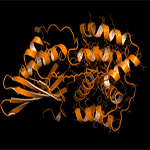Lesbian, Gay, Bisexual, and Transgender Pride Month is celebrated each year in the month of June to honor the 1969 Stonewall riots in Manhattan. The Stonewall riots were a tipping point for the Gay Liberation Movement in the United States. As part of Pride Month, Berkeley Lab profiled scientists in the Biosciences and Computing Sciences Areas. One of the three to share their stories is Andrew Hagen, a postdoc in Cheryl Kerfeld’s group in the Molecular Biophysics & Integrated Bioimaging Division who was also a former graduate student with Jay Keasling at the Joint BioEnergy Institute. Read his about his experiences, along with those of Deb Agarwal and Elijah Goodfriend, on the Berkeley Lab Diversity & Inclusion website.
A Key Step Toward Custom-Made Nanoscale Chemical Factories
Scientists have for the first time reengineered a building block of a geometric nanocompartment that occurs naturally in bacteria. The new design provides an entirely new functionality that greatly expands the potential for these compartments to serve as custom-made chemical factories. The work was led by Cheryl Kerfeld, who holds joint appointments with Berkeley Lab’s  Molecular Biophysics and Integrated Bioimaging Division, UC Berkeley and the MSU-DOE Plant Research Laboratory at Michigan State University. Markus Sutter, a senior research associate in Kerfeld’s group at Berkeley Lab, collected the X-ray diffraction data used in this study in the Berkeley Center for Structural Biology at the Advanced Light Source. Read more at the Berkeley Lab News Center.
Molecular Biophysics and Integrated Bioimaging Division, UC Berkeley and the MSU-DOE Plant Research Laboratory at Michigan State University. Markus Sutter, a senior research associate in Kerfeld’s group at Berkeley Lab, collected the X-ray diffraction data used in this study in the Berkeley Center for Structural Biology at the Advanced Light Source. Read more at the Berkeley Lab News Center.
Nature’s Microscopic Masonry: The First Steps in How Thin Protein Sheets Form Polyhedral Shells
Scientists for the first time have viewed how bacterial proteins self-assemble into thin sheets and begin to form the walls of the outer shell for nano-sized polyhedral compartments that function as specialized factories. Researchers in the Molecular Biophysics & Integrated Bioimaging Division determined the 3-D structure of the basic building block protein from crystallized samples in the Berkeley Center for Structural Biology at the Advanced Light Source. Their findings may eventually help improve drug delivery systems. Read more in the Berkeley Lab News Center.
Orange is the New Red
Cheryl Kerfeld of the Molecular Biophysics & Integrated Bioimaging (MBIB) Division led the discovery that a photo-protective mechanism in cyanobacteria is triggered by an unprecedented, large-scale movement from one location to another of the carotenoid pigment within the Orange Carotenoid Protein.
Extending the Reach of X-ray Scattering
During standard X-ray solution scattering experiments, molecules scatter X-rays as they tumble around during exposures, resulting in a diffraction pattern with matching measurements along all angles due to the full orientational averaging. When X-ray snapshots are collected at timescales shorter than a few nanoseconds, such that molecules are virtually frozen in space and time during the scattering experiment, X-ray diffraction patterns are obtained that are no longer equal along all angles. These measurements are collected using a method called fluctuation X-ray scattering, typically performed on an X-ray free electron laser or on a ultra-bright synchrotron. This technique can provide fundamental understanding of biomacromolecular structure, engineered nanoparticles, or energy-related intermediate-scale materials not attainable via standard scattering methods.
Was this page useful?







